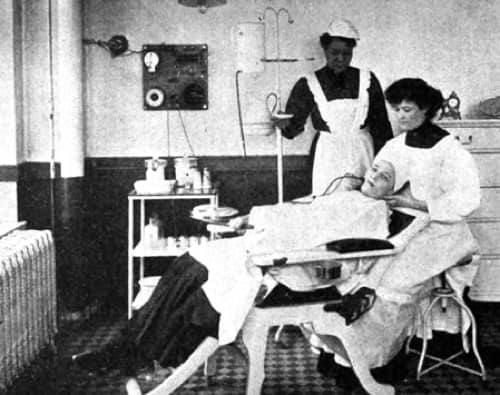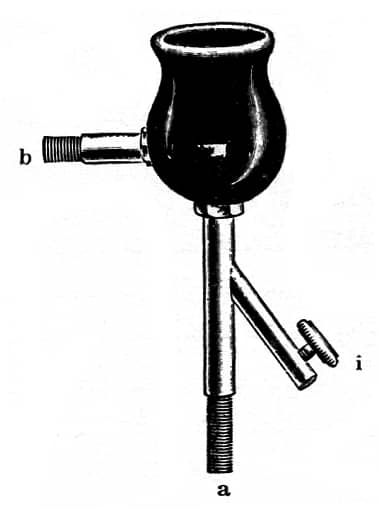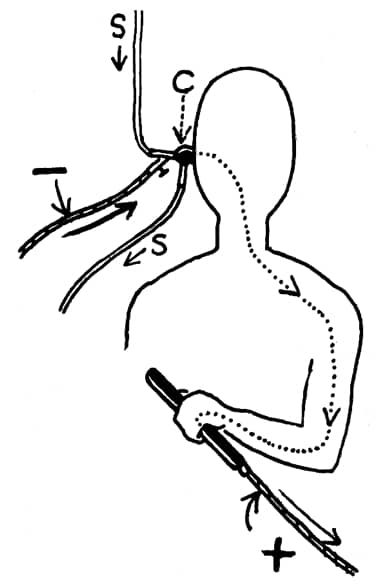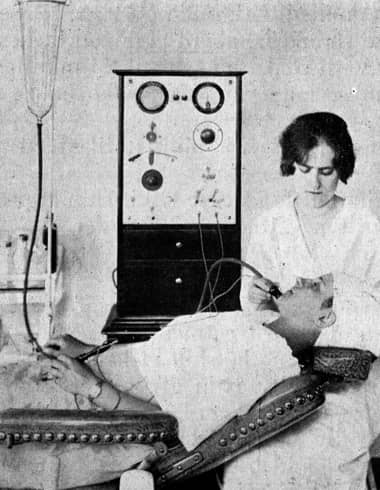Electrolytic Cup
The Electrolytic Cup was an American skin-cleansing device that combined vacuum suction with a galvanic (direct) current. They were used in Marinello salons from 1907 at the latest but may have originated in the Battle Creek Sanitarium founded by John Harvey Kellogg [1852-1943].

Above: An Electrolytic Cup being used at Kellogg’s Battle Creek Sanitarium to treat a skin complaint.
The Electrolytic Cup was a modification of an earlier ‘water massage’ treatment which used water gravity fed from a container placed high above the client to generate a partial vacuum. As the warm water passed through a cup applied to the face it cleansed and removed surface grime and other detritus, while the partial vacuum drew blood to the surface of the skin thereby ‘improving circulation’ and ‘nourishing the skin’.
See also: Vacuum Suction
Adding salt to the water allowed it to conduct an electric current. A negative electrode was then connected to a metal inlet tube attached to the cup so that a galvanic (direct) current could be passed through the water through to the positive electrode held by the client.
The galvanic (direct) current generated an alkali (sodium hydroxide) in the water leading into the Electrolytic Cup which was said to help dissolve the surface of the skin helping with the removal of dirt and grime. This galvanic action had some similarities with later desincrustation treatments, which were introduced in France in the 1930s.
See also: Galvanic Treatments and Desincrustation
Solutions
The action of the Electrolytic Cup could be altered by changing the solution used. A saturated-salt solution was normally employed but if the skin was greasy, a warm soda solution was preferred. If acne was present the Electrolytic Cup could also be used over a medicated soap. For sensitive skin, a solution of soothing boric acid was recommended while an astringent alum solution would help tighten flabbly skin during the cleansing process.
Treatment
Using the Electrolytic Cup was required skill. The strength of the galvanic current had to be adjusted so that it did not irritate the client and the operator had to adjust the pressure they used as the cup glided over the face to avoid water spilling from the cup and discomfort to the client.
A glass container of about two (2) quarts is elevated to about five or six feet from the floor in a convenient spot in your facial booth. … Fill the tank full of water tested for temperature to suit the face. The galvanic current is used for this. Place the negative tip in the binding post of the cup, the patron holding the positive electrode.
A rubber tube leading from tank to cup, carries the water to the face, while another rubber tube leading from the cup to a receptacle on the floor carries it off.
Be sure that the end of the tube in the pail on the floor is covered with water, otherwise it will suck in the air, and cause the tube on the face to be pushed away. Keep the cup well on the face with very light pressure, as too heavy a pressure easily causes bruising of the skin and broken capillaries which are hard to correct.
Work slowly; apply cup to fleshy part of the face first, (centre of cheek for instance, as the suction is secured more quickly) until suction is felt, then by gently moving it over the face, and not raising it, you will soon be able to use it without any loss of water.(WM Meyer, 1936, pp. 376-377)
The outlet tubes were also liable to become blocked by oils or cream that remained on the face after a previous treatment. For this reason it was recommended that the cup be periodically disconnected and water allowed to flow through it to dislodge any obstructions.
Needless to say many Marinello trainees abandoned the procedure. Ruth D. Maurer [1871-1945] (a.k.a. Emily Lloyd) realised this and reproached her students for doing so.
Owing to the fact that the cup is not the easiest thing in the world to manipulate, many Cosmeticians drift away from employing it by offering one weak excuse after another.
Many time, in addition to sheer laziness this indifference comes from the fact that they do not realize the great amount of benefit the subject will receive from its use.(Lloyd, 1915, p. 129)
The practice of using the Electrolytic Cup came to an end after electric pumps replaced the water-massage systems. Electric pumps create a partial vacuum by removing air not by running water. As there was no salt water to conduct electricity there was no point in connecting the cup to a galvanic current. Anyone wanting to use a galvanic current to help cleanse the surface of the skin and make extractions easier would now have to rely on desincrustation.
1st August 2018
Sources
Lloyd, E. (1915). The Marinello text book (2nd ed.). Chicago, IL: Marinello Company.
Wall, F. E. (1946). The principles and practice of beauty culture (2nd ed.). New York: Keystone Publications.
W. M. Meyer Co. (1936). The cosmetiste: A textbook on cosmetology with special reference to the employment of electricity in the care of the hair, scalp, face, and hands, also permanent waving and hair curling (9th ed.). Chicago, Ill: Author.

1915 Diagram of an Electrolytic Cup from a Marinello manual. Water flows from a reservoir through the inlet tube (a) the cup and out through the outlet tube (b) into a bucket. The galvanic current is attached to the cup with a screw (i).

Diagram showing the operation of the electrical current and water flow in the Electrolytic Cup. C. Electrolytic Cup; S. Stream of solution. The dotted line shows the path of the electric current from the cup to the postive carbon electrode held by the client. (Modified from Wall, 1946).

1932 Electrolytic Cup Massage. The galvanic (direct) current is provided from a wall plate but the water is gravity fed from a container placed high above the client. The client is holding the positive electrode (anode) to complete the circuit.
